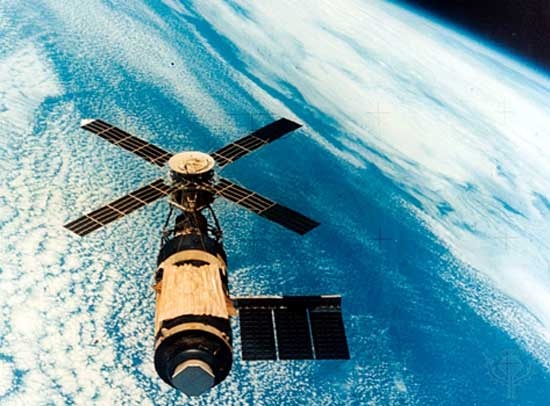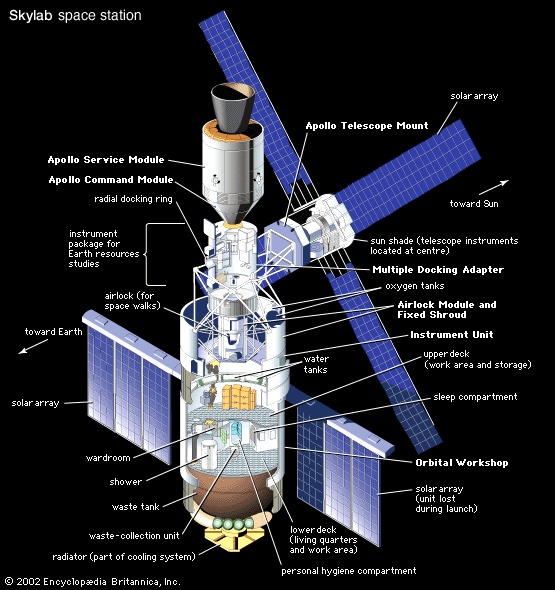Skylab
United States space station
 first U.S. (United States) space station, launched into Earth orbit on May 14, 1973. Three successive crews of visiting astronauts carried out investigations of the human body's adaptation to the space environment, studied the Sun in unprecedented detail, and undertook pioneering Earth-resources observations.
first U.S. (United States) space station, launched into Earth orbit on May 14, 1973. Three successive crews of visiting astronauts carried out investigations of the human body's adaptation to the space environment, studied the Sun in unprecedented detail, and undertook pioneering Earth-resources observations. Skylab was an outcome of the Apollo Applications Program set up by the National Aeronautics and Space Administration (NASA) in 1965 to adapt spacecraft and systems developed for the U.S. Moon-landing program to a variety of scientific missions. As a first step toward establishing a long-term manned platform in space, Skylab made use of a Saturn V Moon rocket, whose third stage was outfitted as a habitat and ready-to-use orbital workshop, and the Command and Service modules of Apollo (Apollo program) spacecraft, which ferried the station's crews and small amounts of supplies. Although limited by its consumable resources in the same way as the Soviet Union's first-generation Salyut stations, Skylab was much roomier and capable of more research. Its main scientific instrument, the Apollo Telescope Mount, incorporated a number of component telescopes and other devices for observing the Sun over a broad range of the electromagnetic spectrum, from visible light through X rays.
Skylab was an outcome of the Apollo Applications Program set up by the National Aeronautics and Space Administration (NASA) in 1965 to adapt spacecraft and systems developed for the U.S. Moon-landing program to a variety of scientific missions. As a first step toward establishing a long-term manned platform in space, Skylab made use of a Saturn V Moon rocket, whose third stage was outfitted as a habitat and ready-to-use orbital workshop, and the Command and Service modules of Apollo (Apollo program) spacecraft, which ferried the station's crews and small amounts of supplies. Although limited by its consumable resources in the same way as the Soviet Union's first-generation Salyut stations, Skylab was much roomier and capable of more research. Its main scientific instrument, the Apollo Telescope Mount, incorporated a number of component telescopes and other devices for observing the Sun over a broad range of the electromagnetic spectrum, from visible light through X rays.During Skylab's ascent a thermal-meteoroid shield was ripped off, which led to the loss of one of the lateral solar power arrays that was to supply electricity to the station and prevented full extension of the other. During their 28-day mission, the first three-man crew deployed an improvised “parasol” sunshade (later fortified with an overlying sun shield) to prevent serious overheating of the station and released the jammed solar array. Skylab hosted two additional three-man crews for missions lasting 59 and 84 days, the latter a space endurance record at the time. Although plans called for Skylab to be used again, increased solar activity caused its orbit to degrade faster than expected. On July 11, 1979, it entered the atmosphere, broke up, and scattered debris over the southeastern Indian Ocean and Western Australia.
- Westmeath
- West Memphis
- West Midlands
- Westminster
- Westminster Abbey
- Westminster Assembly
- Westminster Catechism
- Westminster, City of
- Westminster Confession
- Westminster School
- Westminster, Statute of
- Westminster, Statutes of
- Westmore Family
- Westmoreland
- Westmorland
- Westmorland, Ralph Neville, 1st Earl of, 4th Baron Neville Of Raby
- West, Morris
- West, Nathanael
- West New York
- West Nile virus
- West Nipissing
- Weston
- Weston, Edward
- Weston, Randy
- Weston-super-Mare